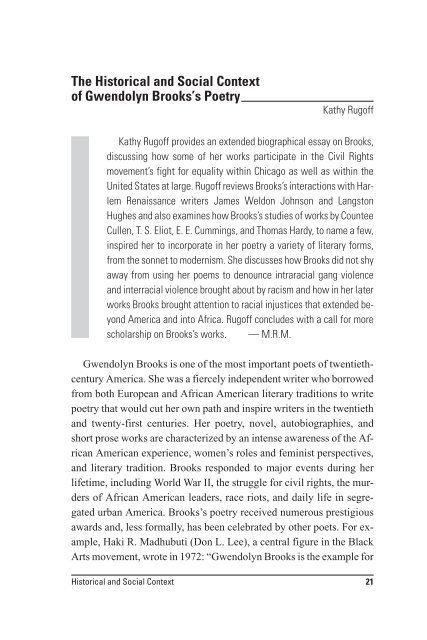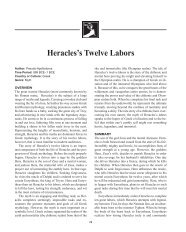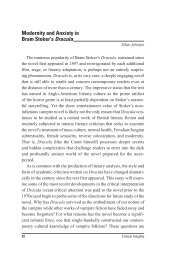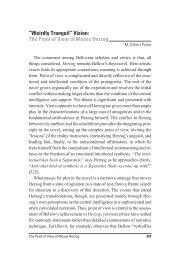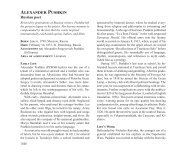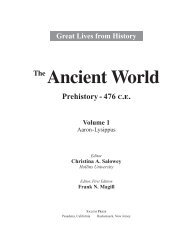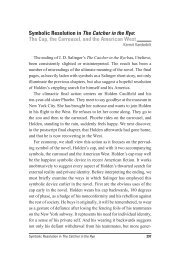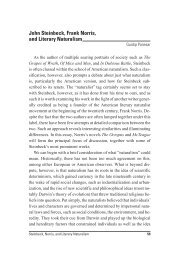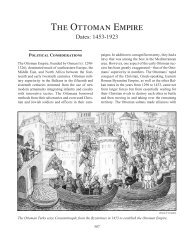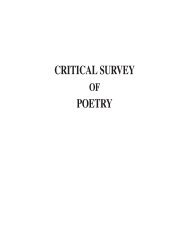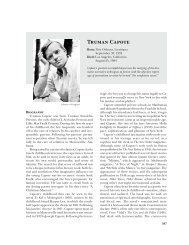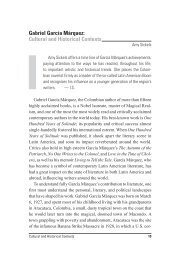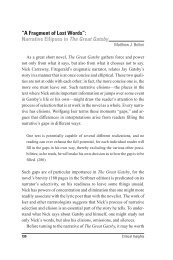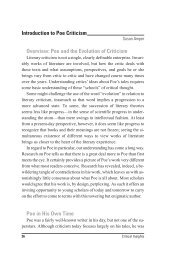The Historical and Social Context of Gwendolyn ... - Salem Press
The Historical and Social Context of Gwendolyn ... - Salem Press
The Historical and Social Context of Gwendolyn ... - Salem Press
Create successful ePaper yourself
Turn your PDF publications into a flip-book with our unique Google optimized e-Paper software.
<strong>The</strong> <strong>Historical</strong> <strong>and</strong> <strong>Social</strong> <strong>Context</strong><br />
<strong>of</strong> <strong>Gwendolyn</strong> Brooks’s Poetry<br />
Kathy Rug<strong>of</strong>f<br />
Kathy Rug<strong>of</strong>f provides an extended biographical essay on Brooks,<br />
discussing how some <strong>of</strong> her works participate in the Civil Rights<br />
movement’s fight for equality within Chicago as well as within the<br />
United States at large. Rug<strong>of</strong>f reviews Brooks’s interactions with Harlem<br />
Renaissance writers James Weldon Johnson <strong>and</strong> Langston<br />
Hughes <strong>and</strong> also examines how Brooks’s studies <strong>of</strong> works by Countee<br />
Cullen, T. S. Eliot, E. E. Cummings, <strong>and</strong> Thomas Hardy, to name a few,<br />
inspired her to incorporate in her poetry a variety <strong>of</strong> literary forms,<br />
from the sonnet to modernism. She discusses how Brooks did not shy<br />
away from using her poems to denounce intraracial gang violence<br />
<strong>and</strong> interracial violence brought about by racism <strong>and</strong> how in her later<br />
works Brooks brought attention to racial injustices that extended beyond<br />
America <strong>and</strong> into Africa. Rug<strong>of</strong>f concludes with a call for more<br />
scholarship on Brooks’s works. — M.R.M.<br />
<strong>Gwendolyn</strong> Brooks is one <strong>of</strong> the most important poets <strong>of</strong> twentiethcentury<br />
America. She was a fiercely independent writer who borrowed<br />
from both European <strong>and</strong> African American literary traditions to write<br />
poetry that would cut her own path <strong>and</strong> inspire writers in the twentieth<br />
<strong>and</strong> twenty-first centuries. Her poetry, novel, autobiographies, <strong>and</strong><br />
short prose works are characterized by an intense awareness <strong>of</strong> the African<br />
American experience, women’s roles <strong>and</strong> feminist perspectives,<br />
<strong>and</strong> literary tradition. Brooks responded to major events during her<br />
lifetime, including World War II, the struggle for civil rights, the murders<br />
<strong>of</strong> African American leaders, race riots, <strong>and</strong> daily life in segregated<br />
urban America. Brooks’s poetry received numerous prestigious<br />
awards <strong>and</strong>, less formally, has been celebrated by other poets. For example,<br />
Haki R. Madhubuti (Don L. Lee), a central figure in the Black<br />
Arts movement, wrote in 1972: “<strong>Gwendolyn</strong> Brooks is the example for<br />
<strong>Historical</strong> <strong>and</strong> <strong>Social</strong> <strong>Context</strong> 21
us all. . . . she is the continuing storm that walks with the English language<br />
as lions walk with Africa” (Brooks, Report from Part One 30).<br />
From her first book, A Street in Bronzeville (1945), to her final publications,<br />
Brooks’s primary focus was on the lives <strong>of</strong> African Americans<br />
in the context <strong>of</strong> evolving social, cultural, <strong>and</strong> political events in<br />
the United States. Her portraits are most <strong>of</strong>ten based on people from<br />
the South Side <strong>of</strong> Chicago, her home. While it is universally observed<br />
that her poetry underwent a transformation in 1967 after she attended<br />
the Second Black Writers’ Conference at Fisk University, Brooks’s<br />
work is remarkably consistent in the brilliance <strong>of</strong> her wit <strong>and</strong> in her<br />
subtle treatment <strong>of</strong> sound <strong>and</strong> its impact on sense.<br />
It is the marriage <strong>of</strong> politics <strong>and</strong> poetics in Brooks that Elizabeth<br />
Alex<strong>and</strong>er—an important twenty-first-century writer <strong>and</strong> the fourth<br />
inaugural poet—admires in her work. 1 In a thought-provoking essay,<br />
Alex<strong>and</strong>er maintains that Brooks’s In the Mecca serves as a model. It<br />
reminds her that “none <strong>of</strong> us lives outside <strong>of</strong> historical moments” <strong>and</strong><br />
that Brooks “never feared or shirked what she fervently believed was her<br />
responsibility; that sense <strong>of</strong> responsibility shaped her very aesthetic.”<br />
Alex<strong>and</strong>er concludes: “Few poets walk with such integrity” (378-79).<br />
Brooks’s poetry is inextricably grounded in the mid-twentieth-century<br />
social <strong>and</strong> political transformation <strong>of</strong> the United States <strong>and</strong> in art’s potential<br />
to engage with the complexity <strong>and</strong> variety <strong>of</strong> experience in African<br />
American life. Rita Dove has also responded to Brooks’s aesthetic.<br />
Like Brooks, but with a focus on earlier events, her collection Thomas<br />
<strong>and</strong> Beulah (1986) <strong>and</strong> other poems include portraits <strong>of</strong> people in daily<br />
life, <strong>and</strong> American Smooth (2004) presents poems in the voices <strong>of</strong> African<br />
American soldiers.<br />
As a writer <strong>and</strong> teacher, Brooks had a major impact on many writers<br />
<strong>and</strong> scholars. Various anthologies <strong>of</strong> poems include tributes to her,<br />
<strong>and</strong> she edited <strong>and</strong> introduced important collections, including A Broadside<br />
Treasury, 1965-1970, <strong>and</strong> Jump Bad: A New Chicago Anthology<br />
(1971). 2 Finally, hundreds <strong>of</strong> critical discussions have appeared on her<br />
work, reflecting various perspectives in literary theory, such as femi-<br />
22 Critical Insights
nism, new historicism, Marxism, <strong>and</strong> New Criticism, <strong>and</strong> in various<br />
fields, such as African American studies <strong>and</strong> cultural studies.<br />
Brooks’s novel Maud Martha, published in 1953, did not receive<br />
much attention at the time <strong>of</strong> its publication, partly because <strong>of</strong> a general<br />
patriarchal bias <strong>and</strong> partly because it did not meet the various expectations<br />
<strong>of</strong> many black <strong>and</strong> white readers; it is now recognized as a<br />
groundbreaking novel <strong>and</strong> is noted for its impact on later novelists.<br />
Maud Martha is a series <strong>of</strong> thirty-four vignettes illuminating the life <strong>of</strong><br />
a woman living in Chicago during the Great Depression <strong>and</strong> the years<br />
<strong>of</strong> World War II. This coming-<strong>of</strong>-age novel responds to inter- <strong>and</strong><br />
intraracial, gender, <strong>and</strong> class divisions. In an important article first<br />
published in the early 1980s, Mary Helen Washington argues that early<br />
responses to the book were symptomatic <strong>of</strong> prejudices that suppressed<br />
the voice <strong>of</strong> African American women, causing the silenced anger <strong>of</strong><br />
the main character to be neither recognized nor understood (54-55).<br />
Later critics have commented on the novel’s originality <strong>and</strong> its feminist<br />
orientation. 3<br />
Early in Brooks’s career, her models were male writers. She was befriended<br />
by Langston Hughes, who praised her work publicly. As a<br />
young girl she read <strong>The</strong> Weary Blues (1926), which opened up a world<br />
<strong>of</strong> possibilities; she realized, among other things, that “writing about<br />
the ordinary aspects <strong>of</strong> black life was important” (Brooks, Report from<br />
Part One 70, 170). This would be the foundation <strong>of</strong> her poetry. She also<br />
wrote bluesy ballads such as her early poems “a song in the front yard,”<br />
“the ballad <strong>of</strong> chocolate Mabbie,” <strong>and</strong> “Sadie <strong>and</strong> Maud” <strong>and</strong> later ones<br />
such as “Priscilla Assails the Sepulchre <strong>of</strong> Love” <strong>and</strong> “Steam Song.”<br />
By the early 1930s Brooks had read poetry by Countee Cullen,<br />
James Weldon Johnson, <strong>and</strong> other poets anthologized in Caroling<br />
Dusk, which was edited by Cullen, <strong>and</strong> in Negro Poets <strong>and</strong> <strong>The</strong>ir<br />
Poems, which was edited by Robert Kerlin (Kent 23). Various poets <strong>of</strong><br />
the Harlem Renaissance wrote sonnets. Brooks also studied wellknown<br />
poems in the traditional canon that appeared in the Winged<br />
Horse Anthology, which was edited by Joseph Ausl<strong>and</strong>er <strong>and</strong> Frank<br />
<strong>Historical</strong> <strong>and</strong> <strong>Social</strong> <strong>Context</strong> 23
Ernest Hill. Upon the suggestion <strong>of</strong> James Weldon Johnson, she became<br />
acquainted with poems by modernist writers such as T. S. Eliot,<br />
Ezra Pound, <strong>and</strong> E. E. Cummings (Brooks, Report from Part One 173).<br />
In 1941, her study <strong>of</strong> modern poetry <strong>and</strong> its techniques intensified<br />
through the influence <strong>of</strong> Inez Cunningham Stark when Brooks attended<br />
a poetry class held in the South Side Community Art Center led<br />
by the well-to-do reader for Poetry magazine. Like the early modernists,<br />
Brooks paid particular attention to elements <strong>of</strong> form. <strong>The</strong> result is<br />
“tense, complex, rhythmic verse,” Houston A. Baker, Jr., observes,<br />
“that contains the metaphysical complexities <strong>of</strong> John Donne <strong>and</strong> the<br />
word magic <strong>of</strong> Apollinaire, Eliot, <strong>and</strong> Pound” (21). Baker concludes<br />
that Brooks’s poetry “equal[s] the best in the black <strong>and</strong> white literary<br />
traditions” (28). 4 In addition, Gertrude Reif Hughes argues, Brooks<br />
transforms some <strong>of</strong> the tenets <strong>of</strong> modern poetry as she undermines<br />
male white hegemony in poetry that reflects a feminist African American<br />
perspective (140-43).<br />
By her late teens, Brooks was contributing to the weekly “Lights<br />
<strong>and</strong> Shadows” column <strong>of</strong> the Chicago Defender, an influential newspaper<br />
with a large readership in the African American community. Her<br />
first book was published by Harper <strong>and</strong> Brothers (later Harper & Row),<br />
a major New York press, followed by six subsequent books. Although<br />
Brooks had a productive relationship with her editors at Harper, her<br />
work was subjected to some “requests for revisions,” which, as John K.<br />
Young points out, “reinforc[ed] the aesthetic <strong>and</strong> political issues behind<br />
white consumption <strong>of</strong> black texts.” In 1969, Brooks began to publish<br />
strictly with black presses, including Broadside <strong>Press</strong>, Third World<br />
<strong>Press</strong>, <strong>and</strong> her own press, David Company (Young 97, 94). She pointed<br />
out in an interview with Young that in the late 1960s Broadside <strong>Press</strong>’s<br />
Dudley R<strong>and</strong>all provided a “platform to young Black poets, people<br />
that Macmillan <strong>and</strong> Harper wouldn’t accept” <strong>and</strong> she “decided to go<br />
with a Black publisher <strong>and</strong> give some assistance to them” (qtd. in<br />
Brooks <strong>and</strong> Hawkins 280).<br />
A Street in Bronzeville exhibits a broad repertoire in tone <strong>and</strong> struc-<br />
24 Critical Insights
ture, from songlike lyrics to sonnets, ballads, <strong>and</strong> other narrative<br />
forms. One critic has observed that the book comprises “a collage <strong>of</strong><br />
racism, sexism, <strong>and</strong> classism <strong>of</strong> America in its illumination <strong>of</strong> the people<br />
who strive to survive Bronzeville” (Bolden 13). Bronzeville from<br />
the 1920s into the 1950s, known as the Black Belt, was the heart <strong>of</strong> the<br />
Great Migration from the South, which began in the nineteenth century<br />
but increased considerably during the 1920s <strong>and</strong> 1930s. <strong>The</strong> community<br />
“on Chicago’s South Side quickly became a ‘Black Metropolis’”<br />
<strong>and</strong> became “the demographic base for Chicago’s literary renaissance<br />
<strong>of</strong> Black writers” (Bolden 3). 5<br />
With a large white audience in mind, Brooks confronts social issues<br />
<strong>and</strong> provides a voice for Chicago’s African American underclass in her<br />
early poetry. Her particular exploration <strong>of</strong> black <strong>and</strong> European literary<br />
traditions is disarming. For example, as a poem that engages its reader<br />
through lively rhyme <strong>and</strong> assonance, “the ballad <strong>of</strong> chocolate Mabbie”<br />
addresses the tragedy in a boy’s ab<strong>and</strong>onment <strong>of</strong> a dark-skinned<br />
schoolgirl for a girl with lighter skin. Not unlike Emily Dickinson,<br />
Brooks, in unidiomatic syntax, in two lines that resist direct paraphrasing,<br />
conveys the acute loneliness <strong>of</strong> the rejected child who learns the<br />
cruel lessons <strong>of</strong>, first, being female <strong>and</strong> therefore at the mercy <strong>of</strong> a<br />
male’s whim <strong>and</strong>, second, <strong>of</strong> having dark skin in a society that privileges<br />
whiteness. Of this innocent child Brooks concludes: “Mabbie on<br />
Mabbie with hush in the heart./ Mabbie on Mabbie to be” (23-24).<br />
“Ballad <strong>of</strong> Pearl May Lee” is in the voice <strong>of</strong> a black woman <strong>and</strong><br />
treats one <strong>of</strong> the most painful <strong>and</strong> inflammatory subjects in African<br />
American history, the lynching <strong>of</strong> a black man accused <strong>of</strong> having sex<br />
with a white woman. 6 Brooks deals with the double tragedy <strong>of</strong> racism<br />
regarding the impact <strong>of</strong> the assumption that white is more desirable<br />
than black as well as the impact <strong>of</strong> the horrendous torture <strong>and</strong> murder<br />
<strong>of</strong> black men by white men. She places this tragedy in the familiar<br />
blues-song figure <strong>of</strong> the unfaithful lover. Here, it appears that a black<br />
woman revels in the consequences <strong>of</strong> her lover’s infidelity in his attention<br />
to a white woman:<br />
<strong>Historical</strong> <strong>and</strong> <strong>Social</strong> <strong>Context</strong> 25
<strong>The</strong>n <strong>of</strong>f they took you, <strong>of</strong>f to the jail,<br />
A hundred hooting after.<br />
And you should have heard me at my house,<br />
I cut my lungs with my laughter<br />
(1-4)<br />
This takes a highly ironic turn several stanzas later as a mob drags the<br />
man from jail <strong>and</strong> hangs him from a tree:<br />
And they laughed when they heard you wail.<br />
Laughed,<br />
Laughed.<br />
<strong>The</strong>y laughed when they heard you wail.<br />
(85-88)<br />
Although Pearl May Lee may be a victim <strong>of</strong> both her lover’s racism<br />
<strong>and</strong> that <strong>of</strong> the murderous whites, Brooks provides her with a powerful<br />
voice through synecdoche <strong>and</strong> metonymic imagery. Pearl May Lee addresses<br />
her dead lover: “You paid with your hide <strong>and</strong> my heart . . .”<br />
(98). His body is destroyed <strong>and</strong> her emotions are damaged. In addition,<br />
she addresses him as “Brother,” rather than lover (93-94). He is one <strong>of</strong><br />
many black men who have been caught up in white violence. Finally,<br />
Pearl May Lee treats whites like objects, not individuals, reciprocating<br />
the treatment blacks have received. <strong>The</strong> white woman has no name <strong>and</strong><br />
is described as a “taste <strong>of</strong> pink <strong>and</strong> white honey” (99).<br />
Black men treating black women as objects is critiqued, among<br />
other things, in “<strong>The</strong> Sundays <strong>of</strong> Satin-Legs Smith,” a highly satirical<br />
third-person portrait <strong>of</strong> a black man. <strong>The</strong> man’s limitations are a consequence<br />
<strong>of</strong> his secondary status in white America. D. H. Melhem points<br />
out that, like Eliot’s “<strong>The</strong> Love Song <strong>of</strong> J. Alfred Prufrock,” Brooks’s<br />
portrait “deals with an antiheroic vision, but it places the protagonist<br />
solidly in his environment” (<strong>Gwendolyn</strong> Brooks 34). While “Prufrock”<br />
may be an interior monologue <strong>of</strong> Prufrock’s musings, “<strong>The</strong> Sundays <strong>of</strong><br />
26 Critical Insights
Satin-Legs Smith” is a satirical portrait <strong>of</strong> a black man who appropriates<br />
the trappings <strong>of</strong> wealthy whites. <strong>The</strong> poem also conveys an ironic<br />
view <strong>of</strong> the trappings <strong>of</strong> high art in white culture through visual imagery<br />
<strong>and</strong> prosody.<br />
Smith is a ghetto prince. His closet “is a vault/ Whose glory is not diamond,<br />
nor pearls,/ Not silver plate with just enough dull shine./ But<br />
wonder-suits in yellow <strong>and</strong> in wine” (44-47). This zoot-suited man survives<br />
by satisfying his appetite for food at Joe’s Eats <strong>and</strong> for sex with<br />
an unnamed woman “with the most voluble <strong>of</strong> veils” (138). One critic<br />
notes that in Smith, “the ‘choice’ <strong>of</strong> race rebellion is here reduced to<br />
consumer preference”; Smith embodies “the displacement <strong>of</strong> historical<br />
consciousness onto the flat surface <strong>of</strong> the material now” (Mullen 164).<br />
<strong>The</strong> speaker <strong>of</strong> the poem—addressing an unidentified “you” <strong>and</strong> the<br />
poet’s reading audience (if these distinctions can be made)—draws attention<br />
to the details <strong>of</strong> Smith’s world: “alleys, garbage pails,” “broken<br />
windows” <strong>and</strong> “foodlessness” (28, 91, 100). Brooks illuminates the contrast<br />
between Smith’s environment <strong>and</strong> his showy clothes (which are<br />
considered in bad taste by whites) by incorporating meter, diction, <strong>and</strong><br />
conventional imagery found in traditional poetry. Many lines, for example,<br />
use blank verse, <strong>and</strong> the diction is elevated. For example, the<br />
poem opens with Latinate words: “Inamoratas, with an approbation,/<br />
Bestowed his title. Blessed his inclination” (1-2). <strong>The</strong> heavy rhyme <strong>and</strong><br />
alliteration may mock Smith, the speaker, <strong>and</strong> the unidentified “you.”<br />
In addition, Brooks refers to a garden <strong>and</strong> includes a catalog <strong>of</strong> flowers,<br />
which is reminiscent <strong>of</strong> English poets from the Renaissance through<br />
the Romantic era. However, “No! He has not a flower to his name”<br />
(32). George E. Kent argues that the poet is addressing “a white observer”<br />
<strong>and</strong> that the “speaker’s vocabulary <strong>and</strong> attitudes create sardonic<br />
tones <strong>of</strong> cool condescension <strong>and</strong> contempt” so that Brooks presents<br />
criticism not only <strong>of</strong> “the hip life” but also “<strong>of</strong> life <strong>and</strong> society” (70).<br />
<strong>The</strong> rarefied society <strong>of</strong> Eliot may be included. “<strong>The</strong> Sundays <strong>of</strong><br />
Satin-Legs Smith” recalls Prufrock in lines such as “Let us proceed.<br />
Let us inspect, together/ With his meticulous <strong>and</strong> serious love” (43-<br />
<strong>Historical</strong> <strong>and</strong> <strong>Social</strong> <strong>Context</strong> 27
44), which brings to mind the “let us” figure in Prufrock, <strong>and</strong> “meticulous”<br />
Eliot’s “Politic, cautious, <strong>and</strong> meticulous” (116). Smith, <strong>of</strong><br />
course, is the inverse <strong>of</strong> Prufrock; one man is a snappy dresser <strong>and</strong><br />
loves women, whereas the other is intimidated by women. Between the<br />
man in a zoot suit <strong>and</strong> a man anxious about rolling up his trousers,<br />
Brooks may very well find the black man to be, in an important respect,<br />
more free.<br />
In an interview concerning literary tradition, Brooks was asked<br />
about her sonnets. <strong>The</strong> sequence <strong>of</strong> twelve sonnets “Gay Chaps at the<br />
Bar,” in A Street in Bronzeville, presents various experiences <strong>of</strong> African<br />
American soldiers who served during World War II. Speaking metaphorically,<br />
suggesting that form is an extension <strong>of</strong> content, Brooks<br />
stated that the poems employ <strong>of</strong>f-rhyme to deal with “an <strong>of</strong>f-rhyme situation”<br />
(Report from Part One 156). This situation may have been the<br />
fact that African American soldiers were treated unequally in the segregated<br />
U.S. armed forces <strong>and</strong> given noncombat <strong>and</strong> nonleadership positions.<br />
Tragically, segregation <strong>and</strong> lynching continued even after the<br />
soldiers returned (Stanford 184). “Gay Chaps at the Bar” is replete<br />
with irony <strong>and</strong> thereby points to the absurdity in the soldiers’ treatment.<br />
<strong>The</strong> use <strong>of</strong> irony is also extensive in the war poetry <strong>of</strong> some early<br />
twentieth-century poets, including Wilfred Owen, Siegfried Sassoon,<br />
<strong>and</strong> Thomas Hardy.<br />
Some <strong>of</strong> the diction <strong>and</strong> imagery in Brooks’s sequence also has ties<br />
to sixteenth- <strong>and</strong> seventeenth-century British poetry, <strong>and</strong> the sonnets<br />
include few contemporary references <strong>and</strong> mention no battles or countries;<br />
instead, universal themes <strong>of</strong> war, death, <strong>and</strong> love emerge. This is<br />
an important part <strong>of</strong> the poet’s subliminal message: black soldiers are<br />
no different from white soldiers <strong>and</strong> should not receive separate <strong>and</strong><br />
unequal treatment. Race relations are dealt with directly in the sonnet<br />
“the white troops had their orders but the Negroes looked like<br />
men.” 7 Brooks considers the absurdity <strong>of</strong> separating the remains <strong>of</strong> the<br />
dead based on race. She writes in the sestet:<br />
28 Critical Insights
A box for dark men <strong>and</strong> a box for Other—<br />
Would <strong>of</strong>ten find the contents had been scrambled,<br />
Or even switched. Who really gave two figs?<br />
Neither the earth nor heaven ever trembled.<br />
And there was nothing startling in the weather.<br />
(10-14)<br />
By invoking conventional seventeenth-century imagery that alludes to<br />
metaphysical <strong>and</strong> existential certainties, Brooks renders distinctions<br />
based on race absurd in two respects: first, straightforwardly, through<br />
the analogies in the images <strong>and</strong>, second, metaphorically, through the<br />
enduring quality <strong>of</strong> these conventional images in the history <strong>of</strong> poetry.<br />
However, Brooks also takes subtle liberties with traditional sonnet<br />
structure, particularly through the use <strong>of</strong> half-rhyme <strong>and</strong> through the<br />
relationship between the rhyme structure <strong>and</strong> the volta. In addition, as<br />
Stacy Carson Hubbard insightfully argues, by appropriating this strictly<br />
structured genre to “embody questions <strong>of</strong> race <strong>and</strong> gender,” Brooks<br />
confronts her reader with the “the ideological power <strong>of</strong> form itself, as<br />
well as the subversions which that same power makes possible” (63).<br />
Many <strong>of</strong> the poems in Brooks’s second book, Annie Allen (1949),<br />
employ traditional forms, which Madhubuti has criticized. He maintains<br />
that the poems focus on “poetic style” rather than on African<br />
American history or culture, thereby implicitly addressing a white audience;<br />
these remarks are followed by his strong praise for her poetry<br />
from 1967 forward (Brooks, Report from Part One 17). B. J. Bolden,<br />
on the other h<strong>and</strong>, claims that in “Annie Allen, Brooks dares to mock<br />
poetic conventions <strong>and</strong> address the ill-treatment <strong>of</strong> a young naive<br />
ghetto girl by infusing her consciousness with the l<strong>of</strong>ty diction <strong>and</strong> romantic<br />
imagery <strong>of</strong> classical poetry” (89).<br />
<strong>The</strong> collection, which comprises three parts—“Notes from the Childhood<br />
<strong>and</strong> the Girlhood,” “<strong>The</strong> Anniad,” <strong>and</strong> “<strong>The</strong> Womanhood”—is<br />
the coming-<strong>of</strong>-age story <strong>of</strong> Annie, who is confronted by racism <strong>and</strong><br />
sexism. <strong>The</strong> first section includes ballads <strong>and</strong> variations <strong>of</strong> the sonnet.<br />
<strong>Historical</strong> <strong>and</strong> <strong>Social</strong> <strong>Context</strong> 29
“<strong>The</strong> Anniad” is in seven-line stanzas recalling octava rima <strong>and</strong> rhyme<br />
royal. It echoes the mock-heroic style <strong>of</strong> eighteenth-century poets, but<br />
the tale is realistic <strong>and</strong> tragic. By ironically using European poetic convention<br />
to convey Annie’s sad fate, in which the realization <strong>of</strong> her<br />
dream is inverted, Brooks suggests the culpability <strong>of</strong> white male narratives.<br />
In the sonnet sequence in “<strong>The</strong> Womanhood,” Brooks’s speaker’s<br />
words are cast in sonnets to present arguments against the institution <strong>of</strong><br />
poverty <strong>and</strong> to highlight the limitations it imposes on African American<br />
women <strong>and</strong> their children.<br />
Several poems in <strong>The</strong> Bean Eaters (1960), Brooks’s third collection,<br />
deal with the murders <strong>of</strong> blacks by racist whites, with a focus on<br />
women’s perspectives. “A Bronzeville Mother Loiters in Mississippi.<br />
Meanwhile, a Mississippi Mother Burns Bacon,” <strong>and</strong> “<strong>The</strong> Last Quatrain<br />
<strong>of</strong> the Ballad <strong>of</strong> Emmett Till” mourn the death <strong>of</strong> Emmett Till,<br />
who was brutally tortured <strong>and</strong> murdered <strong>and</strong> whose body was mutilated<br />
beyond recognition in 1955 in Money, Mississippi. <strong>The</strong> fourteenyear-old<br />
boy from the South Side <strong>of</strong> Chicago was accused <strong>of</strong> whistling<br />
at a white woman. An all-white jury acquitted the men who were<br />
charged with his death. Photographs <strong>of</strong> Till’s body appeared in the Chicago<br />
Defender, as his mother had an open-casket viewing for thous<strong>and</strong>s<br />
to witness. This horrific sight helped press forward the urgency<br />
<strong>of</strong> the Civil Rights movement <strong>and</strong> had no small impact on Brooks. <strong>The</strong><br />
companion poems diacritically present the problem <strong>of</strong> treating atrocity<br />
within the confines <strong>of</strong> a literary form.<br />
In a highly symbolic short narrative, the first poem portrays the<br />
woman who made the accusations against Till <strong>and</strong> hints at her second<br />
thoughts as she watches her children <strong>and</strong> her husb<strong>and</strong>, one <strong>of</strong> the murderers.<br />
<strong>The</strong> glimmerings <strong>of</strong> the woman’s sense <strong>of</strong> guilt come to light as<br />
a bloody redness infuses everything she sees. She also perceives a troubling<br />
violence in her husb<strong>and</strong> as he slaps one <strong>of</strong> his sons after the child<br />
threw a jar at his brother. This pairing <strong>of</strong> brothers symbolically plays<br />
out the violence visited upon blacks by their white brothers. In addition,<br />
through the pairing <strong>of</strong> mothers in the title, Brooks points to the in-<br />
30 Critical Insights
justice in their fates. <strong>The</strong> final line mentions “the last quatrain,” which<br />
introduces the poem that follows, “<strong>The</strong> Last Quatrain <strong>of</strong> the Ballad <strong>of</strong><br />
Emmett Till.”<br />
This short poem, which describes Till’s mother, simmers in understatement<br />
<strong>and</strong> other forms <strong>of</strong> irony. <strong>The</strong> title “<strong>The</strong> Last Quatrain” suggests<br />
earlier quatrains, which in fact are not presented; this intimates<br />
the poet’s hesitation to attempt to put into an art form unimaginable<br />
atrocity. <strong>The</strong> use <strong>of</strong> the technical term “quatrain” raises the subject <strong>of</strong><br />
the relationship between high art <strong>and</strong> the actual, in this case actual horrendous<br />
violence. <strong>The</strong> particular structure <strong>of</strong> Brooks’s poem, its brevity<br />
<strong>and</strong> inclusion <strong>of</strong> concrete visual images, places it in the tradition <strong>of</strong><br />
modern imagist poetry; however, its subject matter <strong>and</strong> the unstated<br />
narrative <strong>of</strong> events represents a major departure from the art-for-art’ssake<br />
orientation <strong>of</strong> various poems by Ezra Pound, H. D., <strong>and</strong> other<br />
modernist writers. Color imagery—“tint <strong>of</strong> pulled taffy,” “red room,”<br />
“black c<strong>of</strong>fee,” “windy grays,” <strong>and</strong> “red prairie”—instead conveys the<br />
dual tragedy <strong>of</strong> the murder: that it was based on color <strong>and</strong> that Till’s<br />
corpse was the manifestation <strong>of</strong> appalling colors (2, 3, 4, 7, 8).<br />
“<strong>The</strong> Ballad <strong>of</strong> Rudolph Reed,” although a narrative, also relies<br />
heavily on imagery as it pursues white-on-black violence. It begins,<br />
“Rudolph Reed was oaken” (1). He is oaken in that he is not deterred<br />
by the hostility <strong>of</strong> his neighbors, even as he is flexible in his ability to<br />
improve his circumstances <strong>and</strong> move into a white neighborhood. After<br />
several incidents <strong>of</strong> v<strong>and</strong>alism, upon the injury <strong>of</strong> his daughter Reed<br />
retaliates by injuring several whites before he is called “nigger” <strong>and</strong><br />
murdered. <strong>The</strong> poem is in traditional ballad form with an abcb rhyme<br />
scheme. Brooks’s tale is an emblem for the actual situation in Chicago<br />
during the 1950s. On the edge <strong>of</strong> Chicago’s South Side, the Trumbull<br />
Park Housing Projects provided hundreds <strong>of</strong> desirable apartments for<br />
lower-class families. When African Americans began to move in,<br />
white resistance <strong>and</strong> outbreaks <strong>of</strong> violence endured for months (Bolden<br />
158).<br />
In the Mecca (1968), which also addresses issues <strong>of</strong> housing, sig-<br />
<strong>Historical</strong> <strong>and</strong> <strong>Social</strong> <strong>Context</strong> 31
naled a major shift in Brooks’s use <strong>of</strong> traditional poetic form. <strong>The</strong> long<br />
poem “In the Mecca” comprises 807 lines in 56 stanzas <strong>of</strong> variable line<br />
length; it is followed by the sequence “After Mecca,” which includes<br />
poems honoring Medgar Evers, <strong>and</strong> Malcolm X, several dedications<br />
for l<strong>and</strong>marks in Chicago, a short sequence titled “<strong>The</strong> Blackstone<br />
Rangers,” <strong>and</strong> other poems. “<strong>The</strong> Blackstone Rangers” is named after<br />
a gang to which Brooks was introduced <strong>and</strong> for the members <strong>of</strong> which<br />
she held poetry workshops. She praises this group, the youths <strong>and</strong> their<br />
girlfriends, feared by whites <strong>and</strong> many blacks; in the second poem in<br />
the sequence, “<strong>The</strong> Leaders,” Brooks proclaims, “<strong>The</strong>ir country is a<br />
Nation on no map” (10). In the Mecca, her final book published by a<br />
white press, was written for an African American audience.<br />
Mrs. Sallie Smith, the mother <strong>of</strong> nine children, is the protagonist <strong>of</strong><br />
“In the Mecca.” She returns home one day from her job as a domestic<br />
<strong>and</strong> discovers one <strong>of</strong> her children is missing. She searches throughout<br />
the apartment building <strong>and</strong> eventually finds her murdered daughter. As<br />
one critic notes, the search for the lost child “reveals the detritus <strong>of</strong> a<br />
failed socioeconomic system, a failed art, a failed religion, <strong>and</strong> their<br />
spawn <strong>of</strong> isolation <strong>and</strong> rage. A general want <strong>of</strong> caritas, Brooks’s major<br />
theme here, defensively mirrors deficiencies <strong>of</strong> the white environment<br />
<strong>and</strong> reflects the Black Mecca as a microcosm” (Melhem, Heroism 17).<br />
<strong>The</strong> name rings with irony. Built in the last decade <strong>of</strong> the nineteenth<br />
century, the Mecca was a tenement in the South Side that was razed in<br />
the course <strong>of</strong> urban renewal projects during the early 1950s (Melhem,<br />
<strong>Gwendolyn</strong> Brooks 158).<br />
<strong>The</strong> disillusionment <strong>and</strong> anger conveyed in “In the Mecca” reflects<br />
the zeitgeist <strong>of</strong> the era. Several major events in the United States in the<br />
early <strong>and</strong> mid-1960s drew much public attention <strong>and</strong>, in some cases,<br />
large public outcry: the Vietnam War, the murder <strong>of</strong> civil rights workers<br />
in Mississippi in 1964, the iconic “I Have a Dream” speech <strong>of</strong> Dr.<br />
Martin Luther King, Jr., <strong>and</strong> the assassinations <strong>of</strong> President John F.<br />
Kennedy <strong>and</strong> Medgar Evers, a major figure in the NAACP, in 1963<br />
(Melhem, <strong>Gwendolyn</strong> Brooks 156). In addition, in 1966 Stokely Car-<br />
32 Critical Insights
michael, the leader <strong>of</strong> the Student Nonviolent Coordinating Committee<br />
(SNCC), issued a call for African Americans to break away from<br />
King’s nonviolence; Carmichael was a central figure in the Black<br />
Power movement <strong>and</strong> a strong advocate <strong>of</strong> pan-Africanism. <strong>The</strong><br />
speeches <strong>of</strong> Malcolm X <strong>and</strong> his murder in 1965 had a significant impact<br />
in the emergence <strong>of</strong> these movements. <strong>The</strong>y dismissed the philosophy<br />
<strong>and</strong> actions <strong>of</strong> the blacks <strong>and</strong> whites <strong>of</strong> the Civil Rights movement<br />
(Kent 196).<br />
Brooks was in the midst <strong>of</strong> writing In the Mecca when she attended<br />
the Second Black Writers’ Conference at Fisk University in April<br />
1967. <strong>The</strong> conference, in which Brooks herself participated, included<br />
speeches, poetry readings, <strong>and</strong> other performances by historians, poets,<br />
<strong>and</strong> other writers; the performance poetry <strong>of</strong> Amiri Baraka (LeRoi<br />
Jones) epitomized the spirit <strong>of</strong> the gathering, <strong>and</strong> he would soon be at<br />
the epicenter <strong>of</strong> the Black Arts movement. Brooks later claimed that<br />
after hearing Baraka’s cry “Up against the wall, white man!” she knew<br />
“there is indeed a new black today. ...Andheisunderstood by no<br />
white” (Report from Part One 85). Brooks would go on to publish<br />
strictly with black presses with a black audience in mind <strong>and</strong> in the<br />
spirit <strong>of</strong> the Black Arts movement. <strong>The</strong> movement flourished in the<br />
1960s <strong>and</strong> associated itself with the Black Power movement, which<br />
celebrated African Americans <strong>and</strong> African culture <strong>and</strong> attacked white<br />
racism <strong>and</strong> seats <strong>of</strong> power. 8 Brooks’s new poetry would retain her predilection<br />
for irony <strong>and</strong> attention to the nuances <strong>of</strong> language.<br />
<strong>The</strong> collection Riot was published in 1969 by Broadside <strong>Press</strong>, a<br />
black press run by Dudley R<strong>and</strong>all, a strong Black Arts advocate. <strong>The</strong><br />
collection includes “Riot” <strong>and</strong> “<strong>The</strong> Third Sermon on the Warpl<strong>and</strong>,”<br />
<strong>and</strong> was published shortly after the assassination <strong>of</strong> Martin Luther<br />
King, Jr., in 1968 <strong>and</strong> the subsequent riots that took place in several<br />
American cities. “Riot” presents a portrait <strong>of</strong> a racist white man from<br />
an old, wealthy American family that was in the slave trade <strong>and</strong> in the<br />
rum <strong>and</strong> opium markets. Cabot, an object <strong>of</strong> derision, is “all whitebluerose<br />
below his golden hair” (2). When a group <strong>of</strong> blacks approach<br />
<strong>Historical</strong> <strong>and</strong> <strong>Social</strong> <strong>Context</strong> 33
him in the street, he thinks them “sweaty <strong>and</strong> unpretty” <strong>and</strong> “not discreet”<br />
(11, 15). As he is destroyed in the riot’s “smoke <strong>and</strong> fire” (28), in<br />
biting irony Brooks reveals his final words: “‘Lord!/ Forgive these<br />
nigguhs that know not what they do’” (29-30). <strong>The</strong> corruption <strong>of</strong><br />
Christ’s words upon his crucifixion, “Father, forgive them; for they<br />
know not what they do” (Luke 23:34), bores to the center <strong>of</strong> white hypocrisy<br />
in the treatment <strong>of</strong> blacks. <strong>The</strong> reference to the Bible also<br />
places the riot within a larger apocalyptic vision. 9<br />
“<strong>The</strong> Third Sermon on the Warpl<strong>and</strong>” is informed by a similar vision.<br />
<strong>The</strong> poem is more than one hundred lines long <strong>and</strong> is told by a<br />
narrator <strong>and</strong> several other voices, including “<strong>The</strong> Black Philosopher,”<br />
a child, a passage from a newspaper, “A White Philosopher,” whites in<br />
general, <strong>and</strong> members <strong>of</strong> the Blackstone Rangers. As in other long<br />
modernist poems, no transitions link the voices; Brooks thus creates a<br />
fractured narrative, <strong>and</strong> a collage effect emerges. Unlike other poems<br />
in this genre, however, the references are primarily to African American<br />
culture, <strong>and</strong> the intended audience is black. <strong>The</strong> epigraph presents<br />
a dictionary definition <strong>of</strong> “phoenix” that refers to the word’s source in<br />
Egyptian mythology, <strong>and</strong> through this reference Brooks implicitly advocates<br />
for pan-Africanism.<br />
<strong>The</strong> poet’s association <strong>of</strong> African American liberty with African<br />
identity also arises in “Young Heroes,” published in Family Pictures<br />
(1970). In this collection, Brooks presents portraits <strong>of</strong> men she admires.<br />
One <strong>of</strong> the young heroes is Keorapetse Kgositsile, a South African<br />
poet <strong>and</strong> activist who lived in Chicago. In humorous but telling<br />
lines, Brooks quotes one <strong>of</strong> his works’ titles, “‘MY NAME IS<br />
AFRIKA!’” <strong>and</strong> responds, “Well, every fella’s a Foreign Country./<br />
This Foreign Country speaks to You,” which resonates on many levels<br />
(35, 36-37). If “You” is the reader, then Afrika is speaking to the<br />
reader; if “You” refers to Kgositsile, then “This Foreign Country” may<br />
be the United States. Through the ambiguity Brooks both explicitly<br />
<strong>and</strong> implicitly calls attention to African identity <strong>and</strong> its relationship to<br />
America. 10<br />
34 Critical Insights
In 1971 Brooks took trips to Nairobi, Kenya, <strong>and</strong> Dar es Salaam,<br />
Tanzania, <strong>and</strong> later to Accra <strong>and</strong> Kumasi in Ghana. Although she was<br />
greatly inspired by these trips, she faced some disappointment. Annette<br />
Debo points out that she was “identified as an ‘Afro-American’<br />
by Africans <strong>and</strong> thus situated as an outsider in their country, despite her<br />
appearance <strong>and</strong> heritage”; consequently, while Brooks was “impressed<br />
with the African people <strong>and</strong> their definitive place in the world, she<br />
[did] not find the Black unity for which she hoped” (171). Nevertheless,<br />
partly in response to her visits to Africa, she addressed apartheid<br />
in poems such as “<strong>The</strong> Near-Johannesburg Boy,” “Winnie,” <strong>and</strong> “Song<br />
<strong>of</strong> Winnie.” After a thoughtful discussion <strong>of</strong> the references to Africa in<br />
Brooks’s poetry, Debo concludes: “In the end Afrika is an expansive<br />
signifier—a linguistic tie to African languages, a center <strong>of</strong> Blackness,<br />
an inspiration, <strong>and</strong> an appellation” (179).<br />
In the poetry <strong>of</strong> her final years, Brooks continued to call upon her<br />
poetic imagination to create portraits <strong>of</strong> African Americans. <strong>The</strong>se<br />
portraits capture moments <strong>and</strong> movements in American history, particularly<br />
African American history. By confronting issues <strong>of</strong> race, gender,<br />
<strong>and</strong> class, her poems are reflections <strong>of</strong> the social, political, <strong>and</strong> artistic<br />
worlds <strong>of</strong> African Americans from the 1930s to the end <strong>of</strong> the twentieth<br />
century. In addition, by borrowing from African American oral <strong>and</strong><br />
written literary traditions as well as from European literary traditions,<br />
Brooks made a remarkable contribution to the history <strong>of</strong> recent American<br />
poetry. It is very likely that in future discussions <strong>of</strong> twentiethcentury<br />
American poetry, the work <strong>of</strong> <strong>Gwendolyn</strong> Brooks will be<br />
given extensive treatment, possibly even more than the work <strong>of</strong> the<br />
seminal poets who captured her imagination as a young woman.<br />
Notes<br />
1. Elizabeth Alex<strong>and</strong>er was the inaugural poet for the forty-fourth president <strong>of</strong> the<br />
United States, Barack Obama. Coincidentally, President Obama’s political experience<br />
includes work as an activist in Chicago’s South Side <strong>and</strong> as a state senator for Illinois’s<br />
thirteenth district, which covers the same area <strong>of</strong> the city.<br />
<strong>Historical</strong> <strong>and</strong> <strong>Social</strong> <strong>Context</strong> 35
2. See also <strong>Gwendolyn</strong> Brooks <strong>and</strong> Working Writers (edited by Jacqueline Imani<br />
Bryant), <strong>The</strong> Chicago Collective: Poems for <strong>and</strong> Inspired by <strong>Gwendolyn</strong> Brooks (Stephen<br />
Caldwell Wright), <strong>and</strong> To Gwen with Love: An Anthology Dedicated to <strong>Gwendolyn</strong><br />
Brooks (edited by Patricia L. Brown, Don L. Lee, <strong>and</strong> Francis Ward).<br />
3. <strong>The</strong>se discussions include articles by Barbara Christian <strong>and</strong> Valerie Frazier.<br />
4. For further consideration <strong>of</strong> Brooks’s literary background, including the poetry<br />
<strong>of</strong> Paul Laurence Dunbar, Melvin B. Tolson, Robert E. Hayden, Emily Dickinson, <strong>and</strong><br />
Wallace Stevens, see “‘Down the Whirlwind <strong>of</strong> Good Rage’: An Introduction to<br />
<strong>Gwendolyn</strong> Brooks” by Maria K. Mootry.<br />
5. For further discussion <strong>of</strong> Chicago writers, see “‘Down the Whirlwind <strong>of</strong> Good<br />
Rage’” by Mootry <strong>and</strong> American Voices <strong>of</strong> the Chicago Renaissance <strong>and</strong> “From Chicago<br />
Renaissance to Chicago Renaissance: <strong>The</strong> Poetry <strong>of</strong> Fenton Johnson” by Lisa<br />
Woolley. Woolley supports <strong>and</strong> problematizes the argument that there were two successive<br />
Chicago Renaissances, a white one that included Carl S<strong>and</strong>burg, <strong>The</strong>odore<br />
Dreiser, <strong>and</strong> Edgar Lee Masters <strong>and</strong> a black one that included Margaret Walker,<br />
<strong>Gwendolyn</strong> Brooks, <strong>and</strong> Richard Wright.<br />
6. Lynching in the United States was instituted by slave owners as a means to control<br />
slaves through murder <strong>and</strong> terror. <strong>The</strong> practice continued long after emancipation<br />
<strong>and</strong> into the mid-twentieth century. In the final decades <strong>of</strong> the nineteenth century alone,<br />
several thous<strong>and</strong> people, mainly blacks, were lynched in the United States. Although<br />
lynchings most <strong>of</strong>ten sprung from accusations <strong>of</strong> murder or robbery, it was “the sexual<br />
fears, guilt, <strong>and</strong> fantasies <strong>of</strong> white men <strong>and</strong> sometimes women (<strong>and</strong> to an almost negligible<br />
degree the actions <strong>of</strong> black men) play[ing] a role in lynching [that] became a central<br />
motif in literary representations” (Callahan 465). This motif is borne out in<br />
Brooks’s treatments <strong>of</strong> lynching in “Ballad <strong>of</strong> Pearl May Lee,” “A Bronzeville Mother<br />
Loiters in Mississippi. Meanwhile, a Mississippi Mother Burns Bacon,” <strong>and</strong> “<strong>The</strong> Last<br />
Quatrain <strong>of</strong> the Ballad <strong>of</strong> Emmett Till.”<br />
7. In addition, grotesque racism persisted not only among individuals but also within<br />
institutions. For example, as Jennifer C. James notes, “the War Department insisted<br />
that black blood donations not be given to white soldiers in spite <strong>of</strong> the American Medical<br />
Association’s <strong>and</strong> Red Cross’s protestations that theories <strong>of</strong> ‘tainted’ black blood<br />
had no basis in science” (James 236). See James’s discussion <strong>of</strong> Brooks’s sonnet (237).<br />
8. For further discussion <strong>of</strong> the Second Black Writers’ Conference at Fisk University,<br />
see George E. Kent’s A Life <strong>of</strong> <strong>Gwendolyn</strong> Brooks (194-202). For further discussion<br />
<strong>of</strong> the poets <strong>of</strong> the Black Arts movement, see William W. Cook’s “<strong>The</strong> Black Arts<br />
Poets.”<br />
9. For further discussion <strong>of</strong> the references in “Riot,” see D. H. Melhem’s <strong>Gwendolyn</strong><br />
Brooks: Poetry <strong>and</strong> the Heroic Voice (192-95).<br />
10. In 1971 Brooks compiled A Broadside Treasury, 1965-1970, one <strong>of</strong> the best collections<br />
<strong>of</strong> the works <strong>of</strong> poets associated with the Black Arts movement. <strong>The</strong> volume<br />
includes poetry by several dozen writers, including Don L. Lee, Walter Bradford, <strong>and</strong><br />
Keorapetse Kgositsile, all <strong>of</strong> whom Brooks addresses in “Young Heroes.” <strong>The</strong> collection<br />
also includes a large group <strong>of</strong> poems honoring the slain Malcolm X <strong>and</strong> a poem by<br />
Brooks eulogizing Dr. Martin Luther King, Jr., that appeared in the Chicago Daily<br />
News the day after his death.<br />
36 Critical Insights
Works Cited<br />
Alex<strong>and</strong>er, Elizabeth. “Meditations on ‘Mecca’: <strong>Gwendolyn</strong> Brooks <strong>and</strong> the Responsibilities<br />
<strong>of</strong> the Black Poet.” By Herself: Women Reclaim Poetry. Ed.<br />
Molly McQuade. St. Paul, MN: Graywolf, 2000. 368-79.<br />
Baker, Houston A., Jr. “<strong>The</strong> Achievement <strong>of</strong> <strong>Gwendolyn</strong> Brooks.” A Life Distilled:<br />
<strong>Gwendolyn</strong> Brooks, Her Poetry <strong>and</strong> Fiction. Ed. Maria K. Mootry <strong>and</strong> Gary<br />
Smith. Urbana: University <strong>of</strong> Illinois <strong>Press</strong>, 1987. 21-29.<br />
Bolden, B. J. Urban Rage in Bronzeville: <strong>Social</strong> Commentary in the Poetry <strong>of</strong><br />
<strong>Gwendolyn</strong> Brooks, 1945-1960. Chicago: Third World <strong>Press</strong>, 1999.<br />
Brooks, <strong>Gwendolyn</strong>. Annie Allen. New York: Harper, 1949.<br />
____________. <strong>The</strong> Bean Eaters. New York: Harper, 1960.<br />
____________. Family Pictures. Highl<strong>and</strong> Park, MI: Broadside <strong>Press</strong>, 1970.<br />
____________. In the Mecca. New York: Harper & Row, 1968.<br />
____________. Maud Martha. New York: Harper, 1953.<br />
____________. Report from Part One. Detroit, MI: Broadside <strong>Press</strong>, 1972.<br />
____________. Riot. Highl<strong>and</strong> Park, MI: Broadside <strong>Press</strong>, 1969.<br />
____________. A Street in Bronzeville. New York: Harper, 1945.<br />
Brooks, <strong>Gwendolyn</strong>, comp. A Broadside Treasury, 1965-1970. Detroit, MI: Broadside<br />
<strong>Press</strong>, 1972.<br />
Brooks, <strong>Gwendolyn</strong>, ed. Jump Bad: A New Chicago Anthology. Detroit, MI:<br />
Broadside <strong>Press</strong>, 1971.<br />
Brooks, <strong>Gwendolyn</strong>, <strong>and</strong> B. Denise Hawkins. “Conversation: <strong>Gwendolyn</strong> Brooks<br />
<strong>and</strong> B. Denise Hawkins.” <strong>The</strong> Furious Flowering <strong>of</strong> African American Poetry.<br />
Ed. Joanne V. Gabbin. Charlottesville: University <strong>Press</strong> <strong>of</strong> Virginia, 1999.<br />
274-80.<br />
Brown, Patricia L., Don L. Lee, <strong>and</strong> Francis Ward, eds. To Gwen with Love: An Anthology<br />
Dedicated to <strong>Gwendolyn</strong> Brooks. Chicago: Johnson, 1971.<br />
Bryant, Jacqueline Imani, ed. <strong>Gwendolyn</strong> Brooks <strong>and</strong> Working Writers. Chicago:<br />
Third World <strong>Press</strong>, 2007.<br />
Callahan, John F. “Lynching.” <strong>The</strong> Oxford Companion to African American Literature.<br />
Ed. Williams L. Andrews, Francis Smith Foster, <strong>and</strong> Trudier Harris. New<br />
York: Oxford University <strong>Press</strong>, 1997.<br />
Christian, Barbara. “Nuance <strong>and</strong> the Novella: A Study <strong>of</strong> <strong>Gwendolyn</strong> Brooks’s Maud<br />
Martha.” A Life Distilled: <strong>Gwendolyn</strong> Brooks, Her Poetry <strong>and</strong> Fiction. Ed. Maria<br />
K. Mootry <strong>and</strong> Gary Smith. Urbana: University <strong>of</strong> Illinois <strong>Press</strong>, 1987. 239-53.<br />
Cook, William W. “<strong>The</strong> Black Arts Poets.” <strong>The</strong> Columbia History <strong>of</strong> American Poetry.<br />
Ed. Jay Parini <strong>and</strong> Brett C. Millier. New York: Columbia University <strong>Press</strong>,<br />
1993. 674-706.<br />
Debo, Annette. “Signifying Afrika: <strong>Gwendolyn</strong> Brooks’s Later Poetry.” Callaloo<br />
29.1 (2006): 168-81.<br />
Eliot, T. S. “<strong>The</strong> Love Song <strong>of</strong> J. Alfred Prufrock.” <strong>The</strong> Complete Poems <strong>and</strong><br />
Plays. New York: Harcourt, 1950.<br />
Frazier, Valerie. “Domestic Epic Warfare in Maud Martha.” African American Review<br />
29.1/2 (2005): 133-41.<br />
<strong>Historical</strong> <strong>and</strong> <strong>Social</strong> <strong>Context</strong> 37
Hubbard, Stacy Carson. “‘A Splintery Box’: Race <strong>and</strong> Gender in the Sonnets <strong>of</strong><br />
<strong>Gwendolyn</strong> Brooks.” Genre 25.1 (1992): 47-64.<br />
Hughes, Gertrude Reif. “Making It Really New: Hilda Doolittle, <strong>Gwendolyn</strong><br />
Brooks, <strong>and</strong> the Feminist Potential <strong>of</strong> Modern Poetry.” <strong>Gwendolyn</strong> Brooks. Ed.<br />
Harold Bloom. Philadelphia: Chelsea House, 2000. 139-59.<br />
James, Jennifer C. A Freedom Bought with Blood: African American War Literature<br />
from the Civil War to World War II. Chapel Hill: University <strong>of</strong> North Carolina<br />
<strong>Press</strong>, 2007.<br />
Kent, George E. A Life <strong>of</strong> <strong>Gwendolyn</strong> Brooks. Lexington: University <strong>Press</strong> <strong>of</strong> Kentucky,<br />
1990.<br />
Melhem, D. H. <strong>Gwendolyn</strong> Brooks: Poetry <strong>and</strong> the Heroic Voice. Lexington: University<br />
<strong>Press</strong> <strong>of</strong> Kentucky, 1987.<br />
____________. Heroism in the New Black Poetry: Introductions <strong>and</strong> Interviews.<br />
Lexington: UP <strong>of</strong> Kentucky, 1990.<br />
Mootry, Maria K. “‘Down the Whirlwind <strong>of</strong> Good Rage’: An Introduction to<br />
<strong>Gwendolyn</strong> Brooks.” A Life Distilled: <strong>Gwendolyn</strong> Brooks, Her Poetry <strong>and</strong> Fiction.<br />
Ed. Maria K. Mootry <strong>and</strong> Gary Smith. Urbana: University <strong>of</strong> Illinois <strong>Press</strong>,<br />
1987. 1-17.<br />
Mullen, Bill V. Popular Fronts: Chicago <strong>and</strong> African-American Cultural Politics,<br />
1935-46. Urbana: University <strong>of</strong> Illinois <strong>Press</strong>, 1999.<br />
Stanford, Ann Folwell. “Dialectics <strong>of</strong> Desire: War <strong>and</strong> the Resistive Voice in<br />
<strong>Gwendolyn</strong> Brooks’s ‘Negro Hero’ <strong>and</strong> ‘Gay Chaps at the Bar.’” <strong>Gwendolyn</strong><br />
Brooks. Ed. Harold Bloom. Philadelphia: Chelsea House, 2000. 43-56.<br />
Washington, Mary Helen. “Rage <strong>and</strong> Silence in <strong>Gwendolyn</strong> Brooks’ Maud Martha.”<br />
<strong>Gwendolyn</strong> Brooks. Ed. Harold Bloom. Philadelphia: Chelsea House,<br />
2000. 43-56.<br />
Woolley, Lisa. American Voices <strong>of</strong> the Chicago Renaissance. De Kalb: Northern<br />
Illinois University <strong>Press</strong>, 2000.<br />
____________. “From Chicago Renaissance to Chicago Renaissance: <strong>The</strong> Poetry<br />
<strong>of</strong> Fenton Johnson.” Langston Hughes Review 14.1/2 (1996): 36-48.<br />
Wright, Stephen Caldwell. <strong>The</strong> Chicago Collective: Poems for <strong>and</strong> Inspired by<br />
<strong>Gwendolyn</strong> Brooks. Sanford, FL: Christopher Burghardt, 1990.<br />
Young, John K. Black Writers, White Publishers: Marketplace Politics in Twentieth-<br />
Century African American Literature. Jackson: University <strong>Press</strong> <strong>of</strong> Mississippi,<br />
2006.<br />
38 Critical Insights


